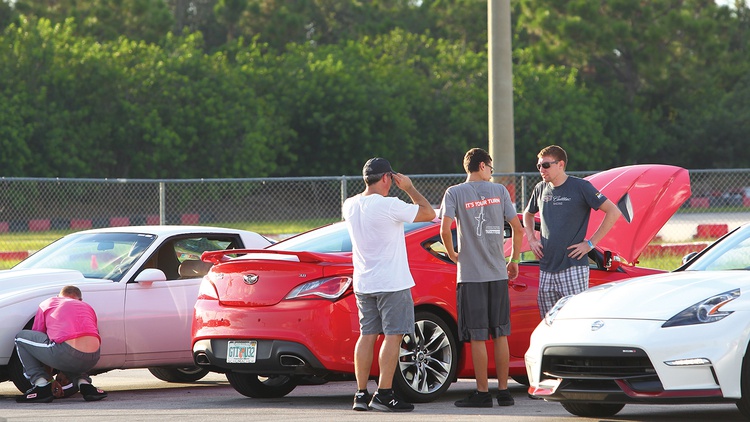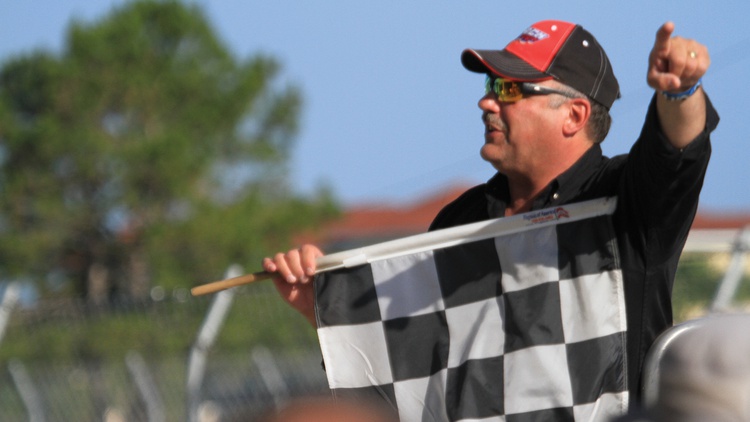Back in the day, getting out on track took some serious commitment. You had to build a race car, go through driver school, and then earn your competition license. Today it’s a bit simpler thanks to the proliferation of non-competitive track events: You go, run laps, have fun, and then head home.
Step 1: Get a Car

You’re going to need something to drive. It doesn’t need to be the latest and greatest. And it definitely doesn’t need 700 horsepower. Other than jacked-up trucks, most passenger vehicles are fine. Different organizations can have different restrictions on convertibles, though, so check the regulations.
Step 2: Check the Brakes
How are the brakes? Fresh fluid? Rotors featuring plenty of meat and free of any defects? Master cylinder and all lines in good condition? Plenty of pad left? (And, ideally, it’s a high-performance pad suited for track work.)
Step 3: Inspect the Tires
You don’t need the latest race tires for your first track day, but yours should be free of any issues. A high-performance model that will remain consistent is a good thing. For tire pressures, we’d recommend the manufacturer’s spec. You can always adjust up or down as necessary.
Step 4: Tech the Car

Most groups will either inspect the car or provide some sort of self-tech sheet that covers the basics. Are the seat belts and seats properly secured? Any damage to the windshield? Does the throttle return spring work as intended? Battery tied down? Fluids fresh and at the proper level? All lugs present and properly torqued?
Step 5: Find an Event

Once you have found your preferred group, pick something on their schedule that works for you. Preregister so you don’t lose your place in line.
Step 6: Get a Helmet
A few groups provide loaner helmets, but they can be a little gross. A new helmet meeting Snell SA2015 specs can start at around $200.
Step 7: Brush up on Skills

Some groundwork can help move you ahead of the curve: Drive that track on your favorite simulator, watch in-car videos on YouTube, and maybe even go to a track day as a spectator. Autocross is a great way to hone those skills, too. For some pre-event reading, we recommend “Look Ahead! Be Smooth!” from our June 2016 issue.
Step 8: Come Prepared
Get a good night’s sleep, pack plenty of water and snacks, smear on some sunblock, and arrive early for the big day. We like to come prepared for most common snafus, so we’ll pack some racer’s tape, zip ties, window cleaner and some rags. Magnetic numbers are today’s standard, but racer’s tape can be used in a pinch. What to wear besides your helmet? A long-sleeve T-shirt, jeans and closed-toe shoes are usually the norm. Don’t forget to regularly torque those lug nuts, too. Once on track, look ahead, watch your mirrors and corner stations, and remember to breathe. Have fun.
UNDERSTANDING HELMET RATINGS

Most track day groups require a helmet carrying either a Snell M (motorcycle and other motorsports) or SA (competitive auto racing) rating. These standards are usually updated every five years, with the 2015 specs released on October 1, 2015. Most groups do not require the latest Snell rating, meaning that SA2010 helmet is likely still good. Specifics can be found on the groups’ sites or in their rules.
How do the SA2015 helmets differ from previous models? The big difference: The mounting points for a head and neck restraint have become standardized and required.
Sources:
New opportunities keep making it easier than ever to get your car on track in a non-competitive environment. Here are some of the clubs and groups that can help.
Autobahn Country Club Joliette
autobahncc.com
(815) 722-2223
Autobahn Country Club, Illinois
BMW Car Club of America
bmwcca.org
(864) 250-0022
National
Chin Motorsports
chinmotorsports.com
(855) 799-CHIN (2446)
National
David Murry Track Days
davidmurry.com/track-days
Eastern
Eastern Motor Racing Association
emraracing.org
Northeast
Hooked on Driving
hookedondriving.com
(925) 328-0800
National
Laps Inc.
lapsincorporated.com
(630) 205-0055
Illinois, Wisconsin
Midwestern Council Sports Car Clubs
mcscc.org
(708) 641-0074
Illinois, Wisconsin
National Auto Sport Association
nasaproracing.com
(510) 232-NASA (6272)
National
North America Road Racing Association
(817) 829-4893
Northeast
Performance Driving Group
performancedrivinggroup.com
(800) 453-5506
Florida
Porsche Club of America
pca.org
(410) 381-0911
National
Povoledo Track Days by Joey G
povoledotrackdays.com
(516) 524-6200
Watkins Glen, New York
The Sports Car Club of America
scca.com
(800) 770-2055
National
Targa Sixty Six
gorace.com
(772) 713-7322
Palm Beach International Raceway
TrackDaze
trackdaze.com
(202) 888-HPDE (4733)
Midatlantic
TheHPDE
(888) 350-HPDE (4733)
Palm Beach International Raceway, Florida
World Racing League
Momentum Performance Driving Academy
idrivemomentum.com
(844) 722-3975
National
This article is from a past issue of the magazine. Like stories like this? You’ll see every article as soon as it's published, and get access to our full digital archive, by subscribing to Grassroots Motorsports. Subscribe now.
































